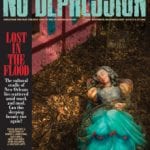Black Rebel Motorcycle Club – The acoustic motorbike
“I feel like we warned people pretty fair. We’d kind of hint that we might make a record like this someday. We tried to brace people a little bit.”
In the days before they changed almost everything, things had not been going well for Black Rebel Motorcycle Club. The trio, who rode their swampy fusion of garage rock and shoegazing pop to the middle of the crowded alt-rock pack, had seen disappointing sales for their second album. They had parted ways with their label, and they weren’t getting along. In the summer of 2004, the group’s guitarist and bassist entered the studio on their own, the drummer’s whereabouts unknown. And came out a country band.
“There was always more to what we were doing than sex, drugs and rock ‘n’ roll,” is the only way bassist Robert Been can explain it. “The purpose had to be greater, and we all had to find that again.”
The group’s new album, Howl, is a sea change of the highest order, the biggest about-face an established act has made in a long time. It’s that much of a shift — like Dylan at Newport, except in reverse, and with less people noticing.
Howl isn’t great enough to make anybody think that B.R.M.C. should have been making records like it their entire career, but it’s still quite good. The mere fact that they’ve managed to pull off a gospel-intensive country-blues album without seeming even faintly ridiculous is a victory in itself.
The members of B.R.M.C. claim, somewhat disingenuously, not to understand what all the fuss is about. So we’ve made a country album, they seem to be saying. Why is that so weird? “I guess I’m surprised,” says guitarist Peter Hayes of the intense reaction to the new record. “I would hope people are more interested in the songs. It’s all about good songwriting. That’s all we really care about.”
If this sounds a bit like backpedaling, maybe it is. It’s entirely possible that the members of B.R.M.C. have realized that this may not be the best time in music history to sound less like the White Stripes. Or — and this is unlikely — it could be that they honestly don’t understand what all the fuss is about.
Both Been and Hayes take great pains to point out the seemingly random countryish touches sprinkled throughout the band’s first two albums. “I feel like we warned people pretty fair,” is how Been puts it. “We’d kind of hint that we might make a record like this someday. We tried to brace people a little bit.” Of course, this is roughly akin to Bon Jovi claiming no one should be surprised if they suddenly turn into a folk band because they once did an acoustic version of “Livin’ On A Prayer”.
Still, Been insists, “For us it’s nothing new. It’s [the same sort of] songs we’ve been playing together since we first got together in high school. It’s no shock to us. But to people outside that, of course it feels like a different animal.”
I fell in love with the sweet sensation
I gave my heart to a simple chord
I gave my soul to a new religion
Whatever happened to you?
…Whatever happened to my rock ‘n’ roll?”
— B.R.M.C., “Whatever Happened To My Rock ‘n’ Roll?”
Been, who until recently went by the stage name Robert Turner so as not to emphasize the connection to his father, Call frontman Michael Been, grew up listening to Sam Cooke, Otis Redding and groups like the Soul Stirrers, all of whom inform Howl to varying extents. Hayes grew up on a farm in New York Mills, Minnesota; he and Been met in high school in San Francisco. The two played and wrote songs together, including many of the bluesy country tracks that found their way, in one form or another, onto Howl.
They joined other bands, but stayed in touch. For a time, Hayes played acoustic coffeehouse gigs. “I’d kind of started out that way. But it always annoyed me, the jabbering, people making coffee in the middle of the song,” he remembers. “So I’d turn it up as loud as possible.”
Hayes (who also played briefly in the infamous Brian Jonestown Massacre) and Been eventually reunited, took on a drummer, expatriate Brit Nick Jago, and named themselves after the motorcycle gang in the Marlon Brando film The Wild One. After moving to Los Angeles and making the usual rounds, the band signed to Virgin Records, which released their debut, B.R.M.C., in 2001.
Fuzzy and bleak, boasting the modest hit “Whatever Happened To My Rock ‘N’ Roll?”, it sold respectably well. B.R.M.C. were immediately, and not inaccurately, lumped in with then-nascent acts such as the Strokes. But selling fewer records than their peers had its advantages. “I always thought that we kind of flew under the radar,” Been figures. “We were free to get away with more than those bands did. Those bands always had more expectations to [merely replicate] what they’d done last time. I didn’t know how trapped we were in [our old] sound until we made this record.”
B.R.M.C. toured constantly, took a lot of drugs, and fought. Problems mounted: After leaving the country, Jago, still a British citizen, couldn’t get back in. The entire group moved to London for a few uneasy months; Jago wasn’t allowed to return to the States until, among other things, Bono intervened.




